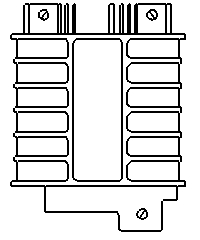|
|
Digital Engine Control Unit (ECU)

Assignment
The digital control device should gather all the information from the sensors, process it and give the suitable signals to the actuators. It is able to communicate with other control devices through the CAN-Bus. It can store measured values and compare them to already stored data (identity fields). In addition, it can ascertain
errors, store them and also start up emergency programs.
Important for the garage, is, apart from the possibility of error and measurement value read-out, also the possibility of re-programming and the ability of modern control devices to serve the actuators (actuator
diagnostic). In this respect, an easy examination of wiring, plug-in connectors and actuators is guaranteed.
Function
Other than displaying the data on a monitor and perhaps additional facilities like sound cards and disk drives, a modern digital control device does not differ from the well known PCs. The processing speed is in fact,
even higher, because it limits itself to data searching, data comparison and data output. It is composed of a micro-processor, a program - and data storage as well as in - and output units.
Input
When possible, the protection of the control device, e.g., against short circuiting, a certain excess voltage and terminal transposing, has priority. In the input components analog signals are transformed into digital,
(A/D converter) and sinus-curves into rectangular signals, or they are counted and filed as numerical values in 8-, 16-or even 32-bit format. This can also take place parallel, as it were, to the processing. Basically not
all of these tasks must be taken care of by the micro-processor, e.g., the communication with the CAN-Bus can be also done by mini-computers (controllers).
Processing
Modern processors are very fast. In the time it takes the crankshaft of a petrol engine turning at 6000 RPMs, to turn only 1°, the slowest processor can handle more than 1000 machine commands. These contain
among other things, the reading out or filing of a numerical value or the flashing through a gigantic data block in search of the right value. A great deal of functions, eg., the Lambda control, have to be artificially braked,
(Hysteresis) to avoid the system over-reacting. To some extent, the operations also run parallel within the processor.It is not a problem for the processor, to gather all the necessary data, like load, RPM etc. between
two ignitions, to process it within rigidly given linkages in a gigantic, multi-dimensional identity field and from this, to determine the next ignition time.
Issue
The output components, as a rule, make up the largest part of the control device. In this case it is a matter of amplifying signals, which is almost always also connected with heat emission which has to be cooled. A
galvanic separation is often also provided. Exactly as with the input components, the protection of the control device in the vehicle is, difficult and at the same time, nevertheless, especially important. Mostly more
sensors, for additional examinations, are installed in the vehicle than are necessary for the actual function. Just imagine, a vehicle engine stops, against the drivers wish, in full power position and the control device
does not notice it or cannot protect itself against it... 05/10
|
|